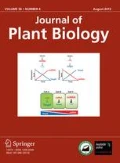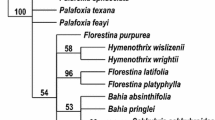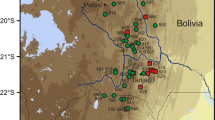Abstract
On the basis of amplified fragment length polymorphism (AFLP) and nucleotide sequence data from nuclear ribosomal internal transcribed spacer (nrITS) and three chloroplast DNA regions (rbcL, cpITS, and trnS-psbC spacer), we investigated the species delimitation and the evolutionary lineage of Isoëtes asiatica from Hokkaido, Japan. The neighbor-joining (NJ) dendrogram based on AFLP markers revealed the well-defined clusters (bootstrap value = 100%) of I. asiatica. Results from the principal component analysis are largely congruent with those obtained in the NJ dendrogram. The maximum parsimony analysis, based on data from nrITS and three chloroplast DNA sequences, supported a monophyly of three species, I. asiatica, Isoëtes echinospora, and Isoëtes maritima from Hokkaido, Kamchatka, and Alaska regions. The distinct species status of I. asiatica was also well supported in the combined chloroplast DNA phylogeny. Therefore, I. asiatica appear to represent example of gradual speciation due to spatial isolation of ancestral populations followed by genetic divergence. Our results also suggest that I. asiatica is probably not the ancestral diploid of the polyploids occurring in East Asia.




Similar content being viewed by others
References
Britton DM, Brunton DF, Talbot SS (1999) Isoëtes in Alaska and the Aleutians. Am Fern J 89:133–141
Cao Y, Adachi J, Janke A, Paabo S, Hasegawa M (1994) Phylogenetic relationships among Eutherian orders estimated from inferred sequences of mitochondrial proteins: instability of a tree based on a single gene. J Mol Evol 39:519–527
Chen D-H, Ronald PC (1999) A rapid DNA minipreparation method suitable for AFLP and other PCR applications. Plant Mol Biol Rep 17:53–57
Chen Y-Y, Yang W, Li W, Li Z-Z, Huang H-W (2008) High allozyme diversity and unidirectional linear migration patterns within a population of tetraploid Isoëtes sinensis, a rare and endangered pteridophyte. Aquat Bot 90:52–58
Choi H-K, Jung J, Kim C (2008) Two new species of Isoëtes (Isoëtaceae) from Jeju Island, South Korea. J Plant Biol 51:354–358
Demesure B, Sodzi N, Petit RJ (1995) A set of universal primers for amplification of polymorphic non-coding regions of mitochondrial and chloroplast DNA in plants. Mol Ecol 4:129–131
Farris JS, Kallersjo M, Kluge AG, Bult C (1995) Testing significance of incongruence. Cladistics 10:315–319
Felsenstein J (1985) Confidence limits on phylogenies: an approach using the bootstrap. Evolution 39:783–791
Goremykin V, Bobrova V, Pahnke J, Troitsky A, Antonov A, Martin W (1996) Noncoding sequences from the slowly evolving chloroplast inverted repeat in addition to rbcL data do not support Gnetalean affinities of angiosperms. Mol Biol Evol 13:383–396
Hickey RJ (1986) Isoëtes megaspore surface morphology: nomenclature, variation, and systematic importance. Am Fern J 76:1–16
Hoot SB, Taylor WC (2001) The utility of nuclear ITS, a LEAFY homolog intron, and chloroplast atpB-rbcL spacer region data in phylogenetic analyses and species delimitation in Isoëtes. Am Fern J 91:166–177
Hoot SB, Napier NS, Taylor WC (2006) Phylogeny and biogeography of Isoëtes (Isoëtaceae) based on nuclear and chloroplast DNA sequence data. Syst Bot 31:449–460
Huang T-C, Chen H-J, Li L-C (1992) A palynological study of Isoëtes taiwanensis DeVol. Am Fern J 82:142–150
Kim C, Shin H, Choi H-K (2009) Genetic diversity and population structure of diploid and polyploidy species of Isoëtes in East Asia based on AFLP markers. Int J Plant Sci 170:496–504
Kott LS, Britton DM (1980) Chromosome numbers for Isoëtes in northeastern North America. Can J Bot 58:980–984
Kott LS, Britton DM (1983) Spore morphology and taxonomy of Isoëtes in northeastern North America. Can J Bot 61:3140–3164
Kuvaev VB (1993) The altitudinal distribution of vascular plants in the mountains of the Kronotskiy reservation (eastern Kamchatka). Botanicheskii Zhurnal 78:25–48
Liu X, Gituru WR, Wang Q-F (2004) Distribution of basic diploid and polyploidy species of Isoëtes in East Asia. J Biogeogr 31:1239–1250
Love A (1962) Cytotaxonomy of the Isoëtes echinospora complex. Am Fern J 52:113–123
Makino T (1904) Observations on the flora of Japan. Bot Mag Tokyo 18:129–131
Makino T (1914) Observations on the flora of Japan. Bot Mag Tokyo 28:174–186
Musselman LJ (2003) Ornamentation of Isoëtes (Isoëtaceae, Lycophyta) microspores. Bot Rev 68:474–487
Pietsch W (1991) On the phytosociology and ecology of Isoëtes asiatica (Makino) Makino in oligotrophic water bodies of South Sakhalin. Vegetatio 97:99–115
Schuettpelz E, Hoot SB (2006) Inferring the root of Isoëtes: exploring alternative in the absence of an acceptable outgroup. Syst Bot 31:258–270
Simmons MP, Ochoterena H (2000) Gaps as characters in sequence-based phylogenetic analysis. Syst Biol 49:369–381
Swofford DL (2002) PAUP*: Phylogenetic Analysis Using Parsimony and Other Methods, ver. 4.02b10. Sinauer, Sunderland
Takamiya M, Watanabe M, Ono K (1994) Biosystematic studies on the genus Isoëtes (Isoëtaceae) in Japan. I. Variations of the somatic chromosome numbers. J Plant Res 107:289–297
Takamiya M, Watanabe M, Ono K (1996) Biosystematic studies on the genus Isoëtes (Isoëtaceae) in Japan. II. Meiotic behavior and reproductive mode of each cytotype. Am J Bot 83:1309–1322
Takamiya M, Watanabe M, Ono K (1997) Biosystematic studies on the genus Isoëtes (Isoëtaceae) in Japan. IV. Morphology and anatomy of sporophytes, phytogeography and taxonomy. APG 48:89–122
Taylor WC, Hickey RJ (1992) Habitat, evolution and speciation in Isoëtes. Ann Mo Bot Gard 79:613–622
Taylor WC, Lekschas AR, Wang QF, Liu X, Napier NS, Hoot SB (2004) Phylogenetic relationships of Isoëtes (Isoëtaceae) in China as revealed by nucleotide sequences of the nuclear ribosomal ITS region and the second intron of a LEAFY homolog. Am Fern J 94:196–205
Thompson JD, Gibson TJ, Plewniak F, Jeanmougin F, Higgins DG (1997) The Clustal X windows interface: flexible strategies for multiple sequences alignment aided by quality analysis tools. Nucleic Acids Res 24:4876–4882
Vos P, Hogers R, Bleeker M, Van de Lee T, Hornes M, Fritgers A, Pot I, Pelemon J, Kuiper M, Zabeau M (1995) AFLP: a new technique for DNA fingerprinting. Nucleic Acids Res 23:4407–4414
Watanabe M, Takamiya M, Matsusaka T, Ono K (1996) Biosystematic studies on the genus Isoëtes (Isoëtaceae) in Japan. III. Variability within qualitative and quantitative morphology of spores. J Plant Res 109:281–296
White TJ, Birns T, Lee S, Taylor J (1990) Amplification and direct sequencing of fungal ribosomal RNA genes for phylogenetics. In: Innis MA, Gelfand DH, Sninsky JJ, White TJ (eds) PCR protocols: a guide to methods and applications. Academic, San Diego, pp 315–322
Acknowledgments
The authors thank Dr. Edith Kapinos (KEW Botanical Garden, UK) for I. asiatica DNA sample from Kamchatka and Y. Ito (University of Tokyo) for collecting the plant materials of I. asiatica in Hokkaido, Japan. We also thank two anonymous reviewers for comments on the manuscript. This work was supported by grants from the Ministry of Environment as parts of the Eco-Technopia 21 project (KIEST 052-071-049) and in part by the Korea Research Foundation Grant (KRF-2009-0073766) to C. K.
Author information
Authors and Affiliations
Corresponding author
Appendices
Appendix 1
Appendix 2
Rights and permissions
About this article
Cite this article
Kim, C., Na, H.R., Shin, H. et al. Systematic Evaluation of Isoëtes asiatica Makino (Isoëtaceae) based on AFLP, nrITS, and Chloroplast DNA Sequences. J. Plant Biol. 52, 501–510 (2009). https://doi.org/10.1007/s12374-009-9064-4
Received:
Accepted:
Published:
Issue Date:
DOI: https://doi.org/10.1007/s12374-009-9064-4




